The iPhone 7 and iPhone 7 Plus Review: Iterating on a Flagship
by Joshua Ho & Brandon Chester on October 10, 2016 8:00 AM EST- Posted in
- Smartphones
- Apple
- Mobile
- iOS
- iOS 10
- iPhone 7
- iPhone 7 Plus
Battery Life
As-is, one of the most important factors for upgrading a smartphone remains battery life, due to a combination of inherent demand for a phone that can last 2-3 days of use and applications that demand enormous amounts of performance over long periods of time. Apps like WeChat are fairly notorious for holding wakelocks on Android and never really stopping background resource usage so there’s also an element of OS optimization that goes with keeping real-world in battery life up to expectations.
In order to test these things, we’ve spent the past year developing and validating a new web browsing battery life test which updates the sites used and introduces a scrolling component which attempts to better model how a number of tasks are not simply race to sleep and contain a steady-state component. We’ve also updated our rundown tests to better reflect reality and maintain appropriate loads as some devices with high-end SoCs and low display resolution were outpacing our testing. As always, all displays are set to 200 nits with location and other background services disabled to reach a useful relative comparison.

Looking at our WiFi web browsing test, it’s genuinely ridiculous how well the iPhone 7 and 7 Plus perform in this test. The iPhone 7 Plus is definitely down on battery life compared to the Galaxy S7 Edge, but it’s within 5% despite using a battery that’s almost 20% smaller. The iPhone 7 is actually comparable in battery life to the iPhone 7 Plus, and is significantly above the Galaxy S7 with Exynos 8890. Of course, the iPhone 7 has a significantly lower resolution display and a smaller battery, but the nature of smartphone design is that larger devices will generally have better battery life because the board area needed remains mostly constant while the amount of area for battery increases. The iPhone 7 has significantly improved in battery life here, likely due to a combination of A10 Fusion's power optimizations – particularly the small CPU cores – and the removal of the headphone jack, which teardown photos show to have been partially replaced with the battery. However if you do the math efficiency sees a relatively minor uplift.
One other interesting point is that Brandon accidentally ran the battery test on his iPhone 7 with a Safari Content Blocker enabled, which blocked all the ads on the sites that the test visits. In doing so, battery life rose from the normal result of 9.22 hours to 10.03 hours, demonstrating how the increased workload and long-running network requests from ads and trackers really impacts a smartphone's battery life. It's also worth noting that our test constantly cycles through pages, so if you spend a lot of time on a single page with ads you could see an even greater difference.
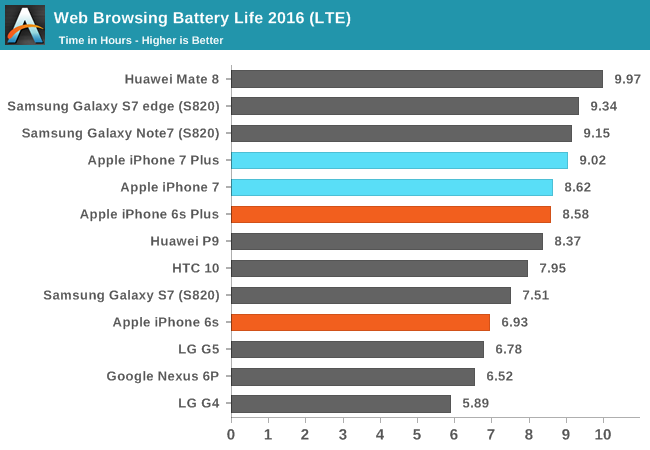
Moving on to LTE battery life the iPhone 7 and 7 Plus both slip a bit, but remain impressive. I suspect that the 20nm Qualcomm modem here is not well-equipped to handle the endless stream of ads that is increasingly a part of most websites. As ads tend to stream in incredibly slowly, the standby power of the modem is a significant factor. Snapdragon 820 devices don’t see nearly the impact here that the iPhone 7 and 7 Plus as their modem is on 14LPP rather than 20SoC. The iPhone 7 remains above the S820 Galaxy S7, but the iPhone 7 Plus is fairly comparable to the iPhone 6s Plus in battery life on LTE.

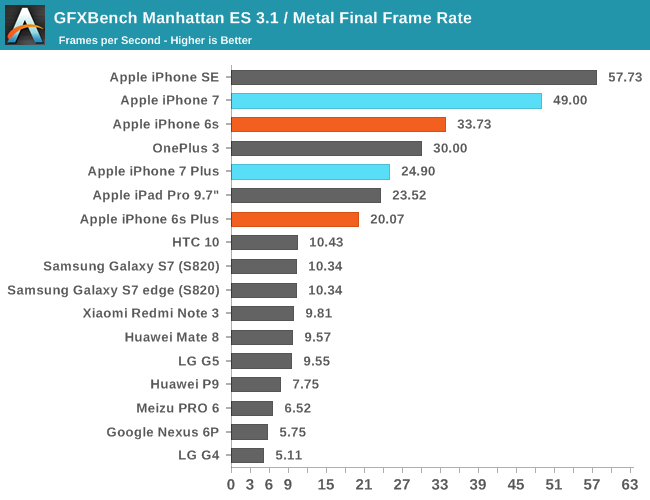
Moving past the web browsing test we use we can take a look at how the iPhone 7 Plus throttles. Unfortunately Basemark OS II was basically broken in this regard for the CPU rundown test so we can only look at how it behaves on Manhattan 3.1, but it's interesting to see how the GPU performance drops about 40% for the iPhone 7 Plus while the iPhone 7 throttles around 20%, because even Manhattan 3.1 is pegged to vsync which means that the GPU can spend much more time idling once a given frame is rendered. It's probably not a surprise here but the iPhone 7 just doesn't last very long here because battery life is strongly SoC-bound. If you attempted to plot battery life as a function of overall SoC utilization, it's entirely possible that the iPhone 7 might last longer than the 7 Plus at the lower bound for utilization, but as soon as you go past web browsing and similarly "light" tasks the 7 Plus and most phablets are going to strongly outperform such a small phone. Here the larger battery helps to get the iPhone 7 Plus nearly another hour of battery life when the SoC is under full, continuous load.
Charge Time
As usual, while battery life is the salient characteristic that determines overall mobility, it’s important to not ignore charge time as there are a number of edge cases where charging has a significant impact on overall mobility. In order to test this we use power measurements at the wall and measure the time it takes from the moment that the charger is plugged in to the moment that it falls below a pre-determined draw from the wall. While this isn’t perfect due to varying levels of DC conversion efficiency and different methods of trickle charging, this method provides at least a reasonable approximation of how long it will take to charge a device.
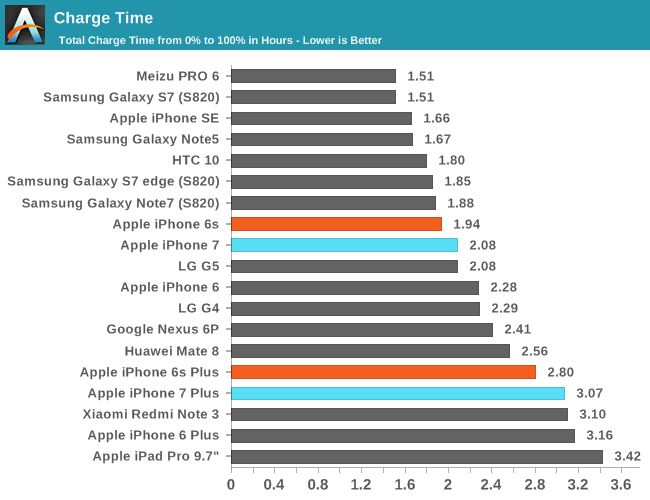
In the case of the iPhone 7 and 7 Plus, Apple continues to ship their standard 5W chargers for US variants. Looking at the results, it’s probably obvious that at least in the case of the iPhone 7 Plus, there is a very real need for Apple to start shipping something with faster charging, as the standard 5W charger takes a full hour longer than most of its competition to charge to 100%. Even the iPhone 7 could use a higher power charger here as using the device while it is charging will significantly impact the charging rate as the charger cannot supply enough power to the board while also charging the battery. And in the case of both phones, the lack of a high power charger doesn't just draw out the total charge time, but it also precludes rapid charging (partially charging a depleted phone very quickly) as well.
It would really be prudent for Apple to start to transitioning to higher power AC adapters at this point. This doesn’t take away from how impressive battery life is, but overall mobility isn’t going to be better than the competition unless you go out of your way to buy an iPad charger.


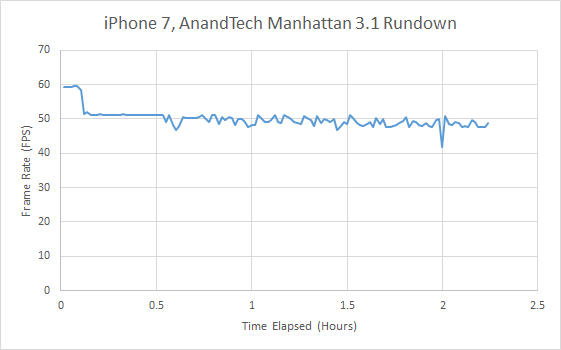
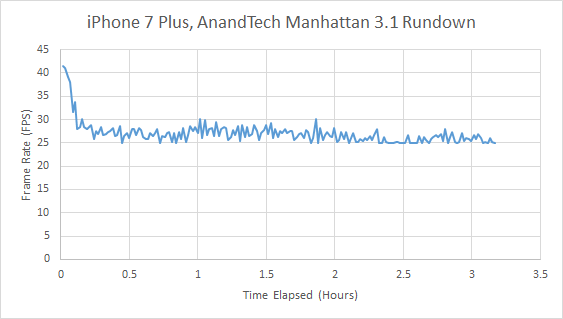
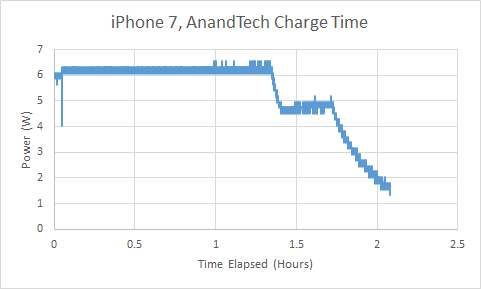
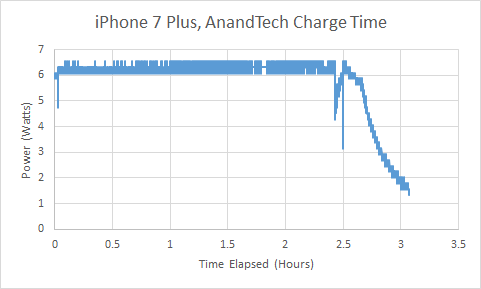








377 Comments
View All Comments
UtilityMax - Wednesday, October 12, 2016 - link
They don't the same OS, but they often run the same applications, so the comparisons are valid. For example, there exist the same web browser benchmarks that run on both OSes.Constructor - Monday, October 17, 2016 - link
On top of the faster CPUs, iOS is also optimized for more efficient resource use plus several special 64 bit optimiziations.Especially memory garbage collection on Android was a bad design mistake which keeps devices stuttering at random intervals.
ACM.1899 - Wednesday, October 12, 2016 - link
"the headphone jack because that’s what users say they want."i have bunch of nice earphones at home and i don't need (want) to buy BT headphones.
they removed the 3.5mm jack and what did they add instead? at least a built in dac (like HTC 10, v10 or v20) would have been nice.
i've heard the sound through the dongle isn't as good as iPhone 6s.
or bluetooth headphones (in general) are not as good as analog headphones (with the same price).
every time Apple does something stupid we say it's because of this or that or for that you can do this or it's the future....but WHY?
for now the only (main) reason is marketing.(Apple & Beats)
as long as a good BT headphone is not the same price as a good analog headphone , i don't want them.
until then the 3.5mm jack should have not been removed.
at least i don't need that bs taptic engine...
ACM.1899 - Wednesday, October 12, 2016 - link
or if Audio (through a smartphone) is that important to me , i can buy an android phone.btw i guess they won't remove it from the mid-range iPhone (SE).
serendip - Wednesday, October 12, 2016 - link
That Redmi Note 3 will be staying at the top of the WiFi web browsing chart for a while longer. How the heck did AT get 12 hours? I've got the same phone and the longest I've seen is 10 hours on WiFi with LTE on but not enabled for data.zodiacfml - Wednesday, October 12, 2016 - link
I love your conclusion piece. I still hate Apple but they are commendable for the constant SoC improvement and the large die size of it. I'd get over the missing headphone jack if the quality of the adapter is good. They did an awesome job on the display too, extracting the best possible performance from the display. I'd get goosebumps if they would the same attention to detail using AMOLED displays for the next generation.I never warmed to the Google Pixel devices as they are too expensive with the unimpressive Snapdragon 821 or 820. I'd just get an S7 Edge for the hardware. The software part is the only missing piece as I'd rather have stock Android with yearly, latest updates from Google.
UtilityMax - Wednesday, October 12, 2016 - link
SoC improvement is fine, but how much SoC improvement do people really need? It's not like smartphones are running PC games or are using for engineering design work. A three year old Nexus 5 with its Snapdragon SoC is still perfectly adequate as a daily smartphone when SoC is concerned. Now, the SD820 offers about twice the performance.blackcrayon - Wednesday, October 12, 2016 - link
How much? An infinite amount. It has to keep increasing in order for smartphone operating systems to get increasingly better. One example is using CPU power to increase photo quality. But no one wants to wait 10 seconds between shots...UtilityMax - Wednesday, October 12, 2016 - link
Your argument is useless because not even a one year old Nexus 5X with a much criticized Snapdragon 808 SoC does not need to take so much time to take a picture. Any modern smartphone has a pretty adequately fast camera. If you find a smartphone with a slow camera that's not an excuse to buy an overpriced iphone with no expandable storage, no "approved" way to upload your media into it without using the iTunes junk, and no 3.5mm headphone jack.blackcrayon - Wednesday, October 12, 2016 - link
Your counterargument is u... nevermind.You need to research what happens when you take a photo on a modern smartphone. There is a lot of processing done in software, which of course utilizes the hardware, to achieve better photos than would be possible without it. I'm not sure what you think your comparison means though. An iPhone "1" could take pictures too. It doesn't mean it could do the kind of instantaneous post processing something like an A10 can do. In this particular case it's Apple's ISP doing much (most?) of the work, but the analogy still stands. In order to add enhancements to the device that can work without drawbacks, they have to be fast. The more speed you have to spare, the more cycles you can use on things like instantaneous image processing, compression/decompression, "AI" that works locally on the phone, etc.
Anyway, the Nexus 5X running Chrome alone should tell you SoCs aren't fast enough, especially with a poorly optimized app.